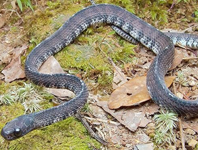Abstract
Chiasmocleis is the most speciose genus of Neotropical microhylids. The genus consists of three monophyletic clades that were recently recognized as subgenera. Within Chiasmocleis, the subgenus Unicus has a basal position in the phylogeny and contains a single species that occurs in the North Atlantic Forest of Brazil, isolated from the ranges of other Chiasmocleis. However, the subgenus Unicus lacked a formal description and consequently so far was a nomen nudum. Herein, we provide a diagnosis (i.e., morphological and molecular apomorphies) of the subgenus Unicus de Sá, Tonini, van Huss, Long, Cuddy, Forlani, Peloso, Zaher and Haddad, 2019b; for convenience, the name has also been registered in ZooBank.
References
Canedo, C., Dixo, M. & Pombal, J.P. (2004) A new species of Chiasmocleis Méhely, 1904 (Anura, Microhylidae) from the Atlantic Rainforest of Bahia, Brazil. Herpetologica, 60, 495–501.
de Sá, R.O., Tonini, J.F.R., van Huss, H., Long, A., Cuddy, T., Forlani, M.C., Peloso, P.L.V., Zaher, H. & Haddad, C.F.B. (2019a) Multiple connections between Amazonia and Atlantic Forest shaped phylogenetic and morphological diversity in the genus Chiasmocleis Méhely, 1904 (Anura: Microhylidae: Gastrophryne). Molecular Phylogenetic and Evolution, 130, 198–210.
https://doi.org/10.1016/j.ympev.2018.10.021
de Sá, R.O., Tonini, J.F.R., van Huss, H., Long, A., Cuddy, T., Forlani, M.C., Peloso, P.L.V., Zaher, H. & Haddad, C.F.B. (2019b) Corrigendum to: “Multiple connections between Amazonia and Atlantic Forest shaped the phylogenetic and morphological diversity of Chiasmocleis Méhely, 1904 (Anura: Microhylidae: Gastrophryninae)”. Molecular Phylogenetic and Evolution, 130, 198–210.
https://doi.org/10.1016/j.ympev.2018.10.021
Dubois, A., Frétey, T. & Ohler, A. (2018) The Relictus case: it is high time that taxonomist follow the Code’s requirements for nomenclatural availability and validity of new zoological nomina. Bionomina, 13, 51–64.
https://doi.org/10.11646/bionomina.13.1.4
ICZN Anonymous (International Commission on Zoological Nomenclature) (1999) International Code of Zoological Nomenclature, 4th Ed. The International Trust for Zoological Nomenclature, London, xxix + 306 p.
ICZN Anonymous (International Commission on Zoological Nomenclature) (2012) Amendment of Articles 8, 9, 10, 21 and 78 of the International Code of Zoological Nomenclature to expand and refine methods of publication. Bulletin of Zoological Nomenclature, 69, 3, 161–169.
https://doi.org/10.21805/bzn.v69i3.a8.161
Jäch, M.A. (2007a) Vandalism in taxonomy. Koleopterol. Rundschau, 77, 38.
Jäch, M.A. (2007b) Vandalism in taxonomy (continued). Koleopterol. Rundschau, 77, 146.
Kaiser, H., Crother, B.I., Kelly, C.M.R., Luiselli, L., O’Shea, M., Ota, H., Passos, P., Schleip, W.D. & Wüster, W. (2013) Best practices: in the 21st century, taxonomic decisions in herpetology are acceptable only when supported by a body of evidence and published via peer-review. Herpetological Review, 11, 1, 8–23.

